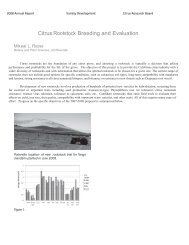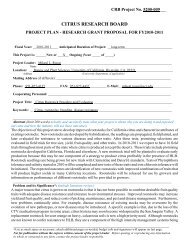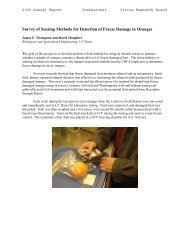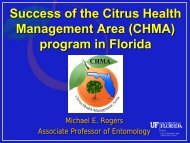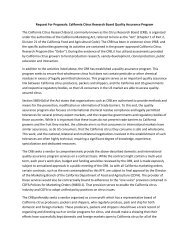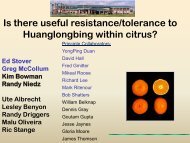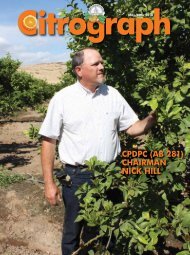Macronutrients: Their Role in Citrus Production - Citrus Research ...
Macronutrients: Their Role in Citrus Production - Citrus Research ...
Macronutrients: Their Role in Citrus Production - Citrus Research ...
You also want an ePaper? Increase the reach of your titles
YUMPU automatically turns print PDFs into web optimized ePapers that Google loves.
<strong>Macronutrients</strong>: <strong>Their</strong> <strong>Role</strong> <strong>in</strong> <strong>Citrus</strong> <strong>Production</strong><br />
David Crowley<br />
Dept of Environmental Sciences,<br />
University of California, Riverside
<strong>Citrus</strong> Nutrition<br />
• Functions of macro- and micro-nutrients<br />
• Interpret<strong>in</strong>g soil and plant analysis reports<br />
• Manag<strong>in</strong>g nitrogen, phosphorus, potassium<br />
Deficiency symptoms<br />
Fertilizer recommendations<br />
• Trace metals
Functions of Essential Elements<br />
• Nitrogen (N)<br />
– Nitrogen is utilized by plants to make am<strong>in</strong>o acids,<br />
which <strong>in</strong> turn form prote<strong>in</strong>s, found <strong>in</strong> protoplasm<br />
of all liv<strong>in</strong>g cells. Also, N is required for<br />
chlorophyll, nucleic acids and enzymes
Functions of Essential Elements<br />
• Phosphorus (P)<br />
– Phosphorus is used to form nucleic acids (RNA and<br />
DNA), it is used <strong>in</strong> storage and transfer of energy<br />
(ATP and ADP)<br />
– P fertilizer stimulates early growth and root<br />
formation, used to drive nutrient uptake, cell<br />
division, metabolism<br />
– Generally sufficient <strong>in</strong> most California soils. Least<br />
response by plants <strong>in</strong> summer with extensive root<br />
systems (tree crops). Ma<strong>in</strong>ly taken up by<br />
mycorrhizae
Functions of Essential Elements<br />
• Potassium (K)<br />
– Potassium is required by plants for translocation of sugars,<br />
starch formation, open<strong>in</strong>g and clos<strong>in</strong>g of guard cells<br />
around stomata (needed for efficient water use)<br />
– Increases plant resistance to disease<br />
– Increases size and quality of fruit<br />
– Increases w<strong>in</strong>ter hard<strong>in</strong>ess
Functions of Essential Elements<br />
• Calcium<br />
– Essential part of cell walls and membranes, must<br />
be present for formation of new cells<br />
– Has been shown to make root tips less leaky,<br />
therefore less attractive to Phytophthora<br />
zoospores<br />
Deficiencies:<br />
poor root development<br />
leaf necrosis and curl<strong>in</strong>g,<br />
blossom end rot,<br />
bitter pit, fruit crack<strong>in</strong>g,<br />
poor fruit storage, and water soak<strong>in</strong>g
Deficient: Excess:<br />
Elements Unit Less than Adequate More than<br />
Nitrogen (N) % 1.6 1.6 -2.4 2.4<br />
Phosphorus (P) % 0.05 0.08-0.25 0.3<br />
Potassium (K) % 0.35 0.75-2.0 3.0<br />
Calcium (Ca) % 0.5 1.0 -3.0 4.0<br />
Magnesium (Mg)% 0.15 0.25-0.80 1.0<br />
Sulfur (S) % 0.05 0.20-0.60 1.0<br />
Boron (B) ppm‡ 10-20 50-100 100-250<br />
Iron (Fe) ppm 20-40 50-100 -<br />
Manganese (Mn) ppm 10-15 30-500 1,000<br />
Z<strong>in</strong>c (Zn) ppm 10-20 30-150 300<br />
Copper (Cu) ppm 2-3 5-15 25<br />
Molybd (Mo) ppm 0.01 0.05-1.0 -<br />
Chloride (Cl) % - - 0.25-0.50<br />
Sodium (Na)% - - 0.25-0.50
Key Pr<strong>in</strong>ciples<br />
Soluble Cations<br />
Electrically neutralized by soluble anions of equal total charge.<br />
Exchangeable Cations<br />
Electrically neutralized by surfaces of solids with negative charge<br />
8
http://www.avocadosource.com/
Soil Sampl<strong>in</strong>g Guidel<strong>in</strong>es<br />
50
http://www.avocadosource.com/
Tak<strong>in</strong>g a leaf sample<br />
Which leaf: The second or third spr<strong>in</strong>g-flush leaf from a<br />
non-fruit<strong>in</strong>g shoot.<br />
When to sample: Preferably October when leaves are 4–<br />
6 months old. Avoid growth which has made a second flush.<br />
Where on the tree: At about shoulder height from all sides<br />
of the tree, or both sides of closely planted rows.<br />
Number of trees: Take leaves from about 20 trees<br />
throughout a uniform and representative section of one<br />
block, follow<strong>in</strong>g a zigzag or ‘X’ pattern <strong>in</strong> the sampled area.<br />
Number of leaves: 60–100 leaves per sample.
Nitrogen<br />
Deficient Satisfactory Excessive<br />
< 1.6 1.6 – 2.4 > 2.4<br />
Nitrogen deficiency symptoms <strong>in</strong> lemon, show<strong>in</strong>g normal<br />
leaf (left), and <strong>in</strong>creas<strong>in</strong>gly chlorotic leaves (left to right).<br />
http://ag.arizona.edu/pubs/crops/az1007/az1007-2.html
Nitrogen cycle<br />
13
Nutrient Availability and Uptake<br />
• Nitrogen fertilizers are typically spread out<br />
over 3 applications to meet plant demand and<br />
avoid leach<strong>in</strong>g.<br />
• Alternative methods for N fertilization <strong>in</strong>clude<br />
Fertigation<br />
Controlled Release Fertilizers<br />
Foliar applications of urea<br />
Organic management
W<strong>in</strong>ter pre-bloom foliar application of low-biuret<br />
urea on yield of Wash<strong>in</strong>gton navel orange.<br />
Ali and Lovatt, 1994<br />
Month urea<br />
Applied<br />
3-Year Cummulative Yield<br />
(kg/tree)<br />
None (control)<br />
256 b<br />
November<br />
305 a<br />
December<br />
308 a<br />
January<br />
338 a<br />
February<br />
321 a<br />
Significance<br />
P
Urea fertilizers can conta<strong>in</strong> Biuret, which is toxic to citrus<br />
and causes trace metal deficiency symptoms<br />
Biuret Toxicity
Overuse of fertilizer will pollute the soil and<br />
irrigation water.<br />
Excessive fertilizer applications may reduce the<br />
yield, and damage fruit quality.<br />
Fruit may have thicker peel, a lower sugar<br />
content and may be late <strong>in</strong> turn<strong>in</strong>g color.
Over-fertilization with Nitrogen<br />
Fruit has thick peel, low sugar content and<br />
delayed color break.
Summary Guidel<strong>in</strong>es for Nitrogen<br />
Tree age determ<strong>in</strong>es how much fertilizer<br />
the tree receives yearly.<br />
A citrus tree <strong>in</strong> California needs between<br />
0.12 lb. of nitrogen at plant<strong>in</strong>g and 1.5<br />
lbs. as adult tree over 6 years old.<br />
At a year old, the tree needs .25 lb. of<br />
nitrogen. Add .25 lb. of nitrogen per year<br />
of age until 6 years.
http://www.avocadosource.com/
Phosphorus Functions <strong>in</strong> Plants<br />
• Energy storage and transfer<br />
– Phosphate compounds are “energy currency”<br />
– (such as ADP and ATP)<br />
• Structural component of biochemicals<br />
– Seed formation<br />
– Calcium and magnesium phytate<br />
– Membrane phospholipids<br />
– DNA<br />
• Root growth, rapid crop establishment<br />
• Early maturity, quicker recovery<br />
2
Influence of pH on Distribution of Inorganic<br />
Phosphorus <strong>in</strong> Soils<br />
Phosphorus “Fixation”<br />
16
Phosphorus Deficiency<br />
Thick coarse r<strong>in</strong>d<br />
Increased acidity<br />
Delayed maturity
Phosphorus Nitrogen Interactions on Fruit Quality<br />
High N Normal N High N<br />
Low P Normal P Low P<br />
Fruit produced on<br />
trees with excessive<br />
N and low P:<br />
Misshapen fruit<br />
Thick, coarse r<strong>in</strong>ds<br />
Open centers<br />
Coarse flesh
Potassium and Fruit Quality<br />
Sufficient<br />
Deficient
• acid sandy soils –<br />
particularly <strong>in</strong> high<br />
ra<strong>in</strong>fall areas<br />
• cold wet conditions<br />
• soils where there have<br />
been heavy <strong>in</strong>puts of<br />
potassium<br />
Note <strong>in</strong>verted V of green at leaf base
Potassium and Phosphorus<br />
Fertilizer Recommendations<br />
• Potassium and phosphorus stay where they are<br />
applied (usually the surface).<br />
• Band<strong>in</strong>g <strong>in</strong> a furrow or on the surface is the best way<br />
to apply superphosphate and potash fertilizer. Deep<br />
placement (15–20 cm) ensures good uptake as the<br />
roots grow through the band.<br />
• Organic matter improves phosphorus movement.<br />
Mulches encourage roots to forage nearer the<br />
surface.
What about the micronutrients
Soil pH effects on metal solubility
High pH soils (low solubility)<br />
Natural lime outcrops<br />
After heavy lim<strong>in</strong>g of soil<br />
Sandy, low pH soils (metal leach<strong>in</strong>g)<br />
Biological<br />
poor root growth<br />
poor conditions for mycorrhizal fungi<br />
poorly dra<strong>in</strong>ed and/or aerated soils<br />
Phytophthora root rot
Z<strong>in</strong>c Deficiency<br />
Deficient Satisfactory Excessive<br />
< 19 19 – 50 > 50<br />
Mottled leaves<br />
Symptoms progress to:<br />
<strong>in</strong>terve<strong>in</strong>al chlorosis,<br />
tip necrosis<br />
small leaf size<br />
twig dieback
http://ag.arizona.edu/pubs/crops/az1007/az1007-2.html
Deficient Satisfactory Excessive<br />
< 30 30 – 130 > 130<br />
Iron deficiency symptoms <strong>in</strong> lemon, show<strong>in</strong>g<br />
normal (right), and <strong>in</strong>creas<strong>in</strong>gly chlorotic leaves.<br />
http://ag.arizona.edu/pubs/crops/az1007/az1007-2.html
Copper Deficiency<br />
Rare<br />
Occurs first on new<br />
growth<br />
Leaves uniform <strong>in</strong><br />
color, long-willow<br />
look<strong>in</strong>g leaves,<br />
bushy appearance,<br />
dieback<br />
Fruit splitt<strong>in</strong>g,<br />
gumm<strong>in</strong>g
Acid Form<strong>in</strong>g Processes: Uptake of NH 4 Nitrogen<br />
Nitrate Ammonium Nitrate Ammonium<br />
NO3 NH4 NO3 NH4<br />
Effect of Nitrogen Form on Rhizosphere pH<br />
19
<strong>Citrus</strong> rootstocks ranked by<br />
susceptibility to Fe chlorosis<br />
lowest<br />
susceptibility<br />
moderate<br />
susceptibility<br />
highest<br />
susceptibility<br />
Sour orange (C. aurantium)<br />
Rough lemon (C. jambhiri)<br />
Cleopatra mandar<strong>in</strong> (C. reticulata)<br />
C. macrophylla<br />
C. volkameriana<br />
Sweet orange (C. s<strong>in</strong>ensis)<br />
Carrizo citrange (C. s<strong>in</strong>esis x P. trifoliata)<br />
Trifoliate orange (P. trifoliata)<br />
Sw<strong>in</strong>gle citrumelo (C. paradisi x P. trifoliata)
Boron Deficiency<br />
Old leaves show scorch<strong>in</strong>g or<br />
yellow<strong>in</strong>g on the marg<strong>in</strong>s and tips,<br />
sometimes with small brown spots.<br />
Mishaped fruit, thick peels,<br />
plugg<strong>in</strong>g of stem / peel<br />
http://www.agnet.org/library.phpfunc=view&id=20110804103731&type_id=2
Boron Toxicity<br />
Boron toxicity (like salt toxicity)<br />
starts as tip yellow<strong>in</strong>g and tip<br />
burn, but subsequent yellow<strong>in</strong>g<br />
of the apex tends to be mottled.<br />
It progresses <strong>in</strong>to a yellow<strong>in</strong>g of<br />
<strong>in</strong>terve<strong>in</strong>ed areas near the tip.<br />
Rootstocks and scions differ <strong>in</strong><br />
susceptibility to boron toxicity.<br />
<strong>Citrus</strong> on rough lemon stock are<br />
more affected than those on<br />
sweet orange or P. trifoliata<br />
rootstock. Lemons are the most<br />
susceptible scion, followed by<br />
mandar<strong>in</strong>s, grapefruit and<br />
oranges.
Correction of Trace Metal Deficiencies<br />
Soil Treatments<br />
Acidification: N-furic, elemental sulfur<br />
Application of z<strong>in</strong>c sulfate, iron sulfate…<br />
Applications of chelated metals (iron and z<strong>in</strong>c)<br />
Foliar Applications<br />
Canopy applications of metal salts<br />
Canopy applications of metal chelates
Foliar Materials:<br />
Chelates (EDTA, Metalosate..)<br />
Zn, Mn, Fe Sulfate
Summary trace metals<br />
Iron, z<strong>in</strong>c, and manganese deficiencies are the<br />
most common and can occur both <strong>in</strong> acid (leached<br />
soils) and alkal<strong>in</strong>e soils (low availability).<br />
Deficiencies may be seasonal and temporary.<br />
Trace metal deficiencies can be solved us<strong>in</strong>g:<br />
efficient root stocks<br />
soil acidification (high pH soils)<br />
chelate applications to soil or foliage<br />
foliar sprays with metal salts
Summary<br />
Many deficiencies have similar symptoms or<br />
may co-occur.<br />
Soil and leaf analyses accurately reveal plant<br />
nutrition problems, and guide methods for<br />
fertilization depend<strong>in</strong>g on the soil type.<br />
Future directions <strong>in</strong> plant nutrition will <strong>in</strong>volve<br />
computer model<strong>in</strong>g and onl<strong>in</strong>e decision<br />
support tools for optimiz<strong>in</strong>g yields, fruit quality,<br />
and plant health.




